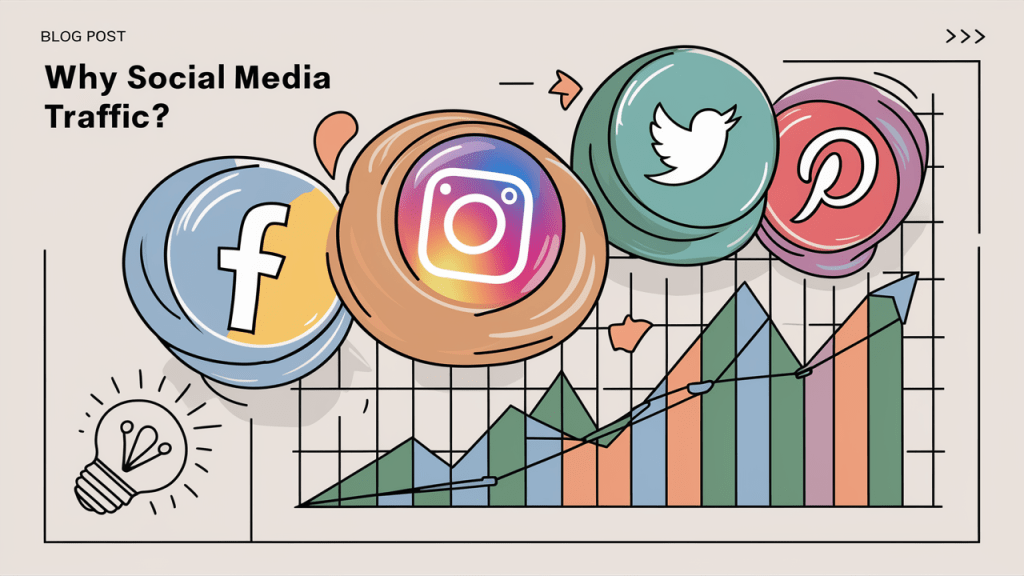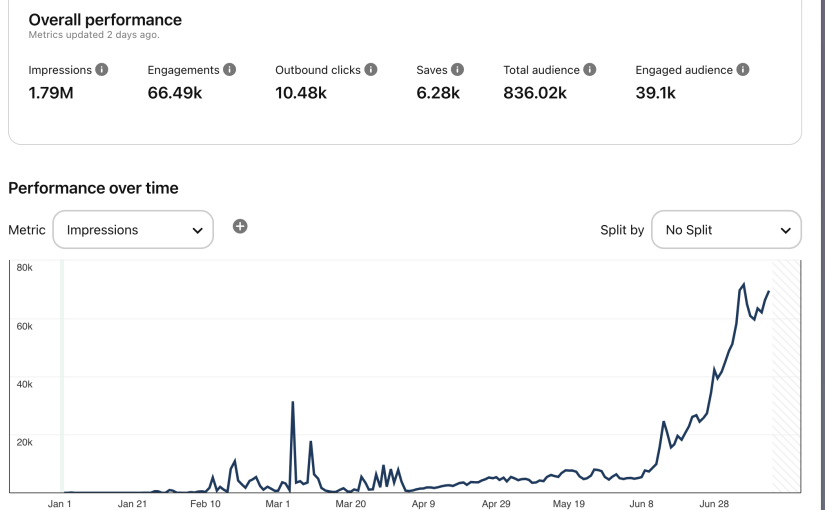I’ve started experimenting with growing a Pinterest page to send traffic to my website and monetize it using display ads. This post will be pretty high-level, but I intend to share more about my strategies in the future.
I’ll share why I chose Pinterest, why social media traffic is working, my goals for this site, and what I plan to do next. Let’s get into it.
Why Pinterest?

If you’re involved in web publishing, you are probably aware of the current state of Google search. If not, I’ll give a quick overview.
People have been producing and monetizing informational content using ads and product review content using affiliate links for many years. These posts were heavily optimized for Google search organic traffic. The great thing about Google traffic is that it’s typically a pretty stable traffic source once you rank. It takes longer to get results, but those results used to stick fairly well. This depends on the competition in the niche, though.
Content producers recognized the opportunity with organic Google search traffic. We all studied the algorithm and found different ways to optimize our content for Google. This is known as Search Engine Optimization (SEO).
A popular method was targeting the long tail of Google searches. These searches don’t get as many monthly searches as larger topics, but there was less competition, making it easier to capture that smaller traffic. I believe this benefited Google because it filled gaps where they didn’t have content to serve those long-tail queries.
Then, in 2023, Google started making major changes that hurt these smaller publishers, targeting information-type content. They rolled out the Helpful Content Update (HCU), which started to penalize some of these sites. Then, they continued to roll out update after update, removing these sites from the top search results in favor of large publishers like the New York Times.
At some point they released an update that heavily boosted User Generated Content (UGC) sites like Reddit and Quora. Almost a huge percentage of queries end up with these sites in the top few spots. I understand that some users like to read Reddit threads on product reviews and other things. I don’t find Reddit helpful because the threads always end up in a flame war, but some users like it. In my opinion, Quora is one of the worst websites that exists.
We also found out that Google has a deal with Reddit. No doubt there is some shady shit going down here.
Every update continued clapping (destroying) the traffic coming to these smaller sites in favor of dominant publishers. It’s been over a year now, and there are no signs that any of the sites are recovering.
To top that off, Google’s hs been gaslighting publishers, claiming that changes are coming. Their liason’s on X often claim it’s the publishers’ fault for producing unhelpful content. One of their talking heads even trolls niche site owners regularly. They often go back and delete thier old tweets so they are hard to find. Very shady behavior.
The short here is that Google traffic is drying up. Google does not intend to return that traffic to the types of sites that used to work. It’s gotten to the point that people outside the SEO world are complaining about the poor quality of Google results, but Google has clarified that they think the results are fine.
Publishers waiting for recovery are going to be waiting a long time. Don’t hold your breath.
Why Social Media Traffic?

Years ago, social media traffic was a hot topic. Specifically, Facebook, before Pinterest gained so much popularity. Then, at some point, it seemed to become less popular in favor of easy SEO traffic. I think some changes to the social algorithms that reduced traffic to sites may have spurred this.
With Google’s changes, I started seeing this discussion emerge again. The more I looked into it, the more I realized that it’s still a viable traffic source. To my surprise, there were people still quietly cashing in on social media traffic.
I looked into the traffic sources and found out the two sources are monsters: Facebook and Pinterest. The type of content that does well differs between the two sites and is completely different from what works for SEO.
My sites also got clapped by Google. I still get traffic from other search sources like Bing, DuckDuckGo, and others. Google traffic has pretty much dried up. Since they don’t intend to fix the issues, or even acknowledge that they have a problem, I’m not going to worry about Google for now.
Why I Chose to Focus on Pinterest
Pinterest was interesting to me because most of the high performing content on Pinterest is visual. Things like design inspiration, fashion, etc. This type of content is relatively easy to publish by finding interesting images that you can include in your blog posts.
With the AI explosion, image generation started getting good enough for me. One of my strong points is automation, so I thought I could automate the process of creating these listicle articles that are a huge list of images with a description of each image. I knew these did well on Pinterest.
I have several different scripts to create content specifically for Pinterst. I also have a bunch to create content for my Facebook pages, but that is for another post.
Another really good reason to choose Pinterest is that they tend to send impressions to new accounts.
Another really good reason to choose Pinterest is that they tend to send impressions to new accounts. On Facebook you really need to work on build your page likes or followers to get any kind of exposure. On Pinterest you can get exposure to users with no followers. This is a huge advantage when you are starting out.
Figuring Out the Pinterest Algorithm

One of the things that I really like is trying to figure out how these systems work and exploit them. That’s one thing that drove me to SEO. I felt like I was “outsmarting” Google, even if it was short-lived. That feeling me a huge rush of dopamine or something.
When you get down to it, Pinterest is a different type of search engine. So some of the techniques are similar to SEO and some are a bit different. Things that might be considered bad practices for SEO can actually work on Pinterst. Like including a ton of different search terms in the description. This would be considered “keyword stuffing” in the SEO world and doesn’t work.
Anyway, I started testing these posts in one of the top niches on Pinterest. At first I was manually Pinning and not seeing much success. I started the account around the beginning of 2024 but didn’t put much effort into it because it didn’t seem to work initially.
What Is Working For Me on Pinterest
I saw some other people have success on Pinterest so I turned my focus to it in early June 2024. I started creating more content specifically for Pinterest on topics that are popular and visual. You can find trending Pinterest topics using their trends tool.
I start producing many, many more pins. I found that pin volume is pretty important, and Pinterest is a bit lenient on how many pins you can post per day. For example, the native scheduler tool allows you to import 200 pins per day.
I created a few dozen posts and then started pinning about 10 pins per day. I quickly ramped that up to 30 per day. I’m slowly increasing it now. I don’t want to go too aggressive because it might be considered spam.
The only way to produce that many pins is to use an automated solution that can generate Pins in bulk. You can technically do this with Canva, but it’s too manual for me. I found a tool called PinGenerator that works really well for this.
PinGenerator has drastically changed my Pinterest game. After focusing on the site for just 30 days, I saw some decent traffic coming in. Pinterest quickly became my top traffic source. Not only on this made-for-Pinterest site but also on some other sites where I pivoted to social media traffic from search engines.

At this point I was not monetizing the site. I was growing traffic with the intention of getting into an ad program. I was hoping to use either AdSense, Ezoic, or Journey by Mediavine.
I added the Grow plugin, which is a requirement for Journey. After a few weeks they accepted me into Journey. Now, I’m able to make money from this traffic using display ads.
It’s too early to talk about numbers, but the RPM (Revenue per thousand sessions) is trending in the right direction.
Pinterest Goals

I set a goal to reach a “vanity metric” of 1 million impressions on Pinterest. I call it a vanity metric because in the grand scheme impressions mean nothing to me. Outbound clicks are what makes money, impressions don’t. However, I hit this goal just after 30 days, which was much quicker than I thought.
The next goal I had was 10k outbound clicks in 30 days. I’m getting very close to that goal and it seems like I should hit it soon. I feel pretty good about my ability to hit this goal.
The next goal I set will be around growing ad revenue, though I don’t have the exact number to share yet. I need to let the ad network learn and adjust so that I can see what the RPMs will look like before I can set a realistic goal.
My ultimate goal will be to onboard this site on the Mediavine Ad Network. This is the more exclusive network and has higher traffic requirements than Journey. It also has higher RPMs which increase earnings.
What’s Next?
I plan to share more about this Pinterest journey on this blog and my YouTube channel. I may also share the journey of building my Facebook pages. However, I do have a slight problem of not being able to focus on one thing and need to put more focus more on Pinterest because it’s working.
I’m even kicking around the idea of creating web apps to help people produce and market social media content.
Look for updates on this in the future. If you want to follow this journey, sign up for my mailing list below. I’ll let you know the latest updates on the progress. You can also follow me on X to get realtime updates.

